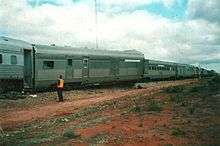Zanthus train collision
The Zanthus train collision occurred at a crossing loop on the Trans-Australian Railway between Perth and Sydney on 18 August 1999. It is located 739 km (459 mi) east northeast of Perth and 202 km (126 mi) east of Kalgoorlie in Western Australia, on the Nullarbor Plain.

| Zanthus train collision | |
|---|---|
| Details | |
| Date | 18 August 1999 |
| Location | Zanthus, Western Australia 739 km (459 mi) ENE from Perth, Western Australia |
| Country | Australia |
| Line | Trans-Australian Railway |
| Operator | National Rail Corporation, Great Southern Rail |
| Incident type | Collision |
| Cause | Driver error |
| Statistics | |
| Trains | 2 |
| Deaths | 0 |
| Injuries | 21 |
Incident
On 18 August 1999 an eastbound freight train was waiting at the departure end of the crossing loop for the westbound Indian Pacific passenger train to pass through.[1]
The second engineman was waiting at the control panel for the points for the opposing train to pass through. Out of habit he had the control panel box unlocked and opened. Unfortunately, out of habit, he pressed the button to operate the points at an inappropriate time, and the opposing train was diverted at a speed of about 40 km/h (25 mph) into the loop where it could not stop in time to avoid a head-on collision. The actual speed of impact as recorded by the locomotive data logger on NR 15 was 27 km/h.
Injuries and damage
Twenty-one passengers and crew from the Indian Pacific were airlifted by the Royal Flying Doctor Service to Kalgoorlie Hospital from the remote Coonana airstrip, 40 km (25 mi) from the crash site. Only two passengers were admitted for overnight observations. Westrail provided two Prospector railcars to transfer the remainder of the passengers back to Kalgoorlie.
All nineteen coaches of the Indian Pacific received varying degrees of damage, from minor internal damage to the write-off of luggage/smoking car HM311; some abandoned wrecked carriages are still at the site.[2] At the time, Great Southern Rail estimated the damage to the coaches to be of the value of $5 million. National Rail Corporation estimated the damage to locomotives NR15 and NR51 at around $1 million.
Aftermath
Since the accident, the operation of the points at this and other crossing loops has been altered so that the point indicator lights will not operate until the access process is completed,[3] and this gives all trains time to stop at the red point indicator lights.
The simplified overview of process is:
- access box - 120-180 second delay all line points are/changed to red
- door opens
- 60-90 second delay until point control inputs are accepted, points can then be changed.
- close door/seal box, lights are changed to indicate point positions.
All traffic then proceeds as directed.
This accident happened because the points were not fully interlocked, and were merely a kind of power-assisted hand lever, with automatic normalisation.
Notes
- "Rail Safety Investigation Report 001 - Collision between Indian Pacific Passenger Train 3AP88 and Freight Train 3PW4N". Australian Transport Safety Bureau, Department of Transport and Regional Services, Government of Australia. Retrieved 9 June 2007.
- "Zanthus train wreck". The Degree Confluence Project. Retrieved 30 September 2008.
- "Independent Investigation report section" (PDF). section 1.12.2 pg 20.CS1 maint: others (link)
External links
- Railfan report
- "Collision Indian Pacific Passenger Train 3AP88 and Freight Train 3PW4N" (PDF). 14 September 1999. Retrieved 28 January 2008.
- ATSB Report